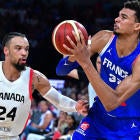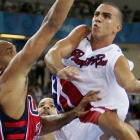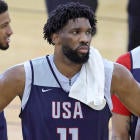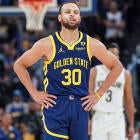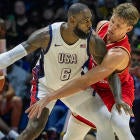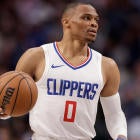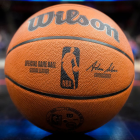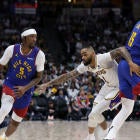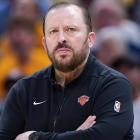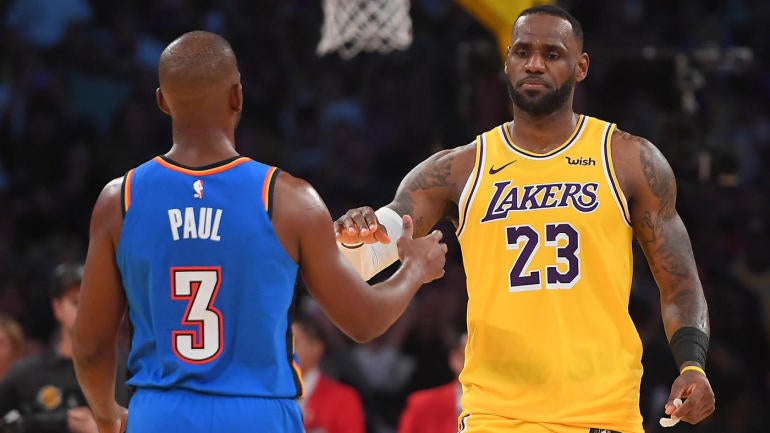
The Lakers are inevitable. It takes years of planning for a normal team to win a title. The process is meticulous and frustrating and random and cruel and usually unforgiving. A missed draft pick here, a wasted mid-level exception there, these are the sorts of mistakes that derail ordinary contenders. The Lakers don't play by the same rules. Their backup plan just won a championship.
It's the reality that every team chasing them needs to dread. The team the Lakers just built wasn't even the one they wanted. Plan A was Kawhi Leonard. He chose the Clippers. So they turned to Plan B, the few remaining free-agent role players left on the market six days after the frenzy began. Plan B was enough to win them a championship in 2020.
Plan B won't be necessary for 2021. The Lakers have no illusions of free-agent glory this offseason. What they do have is the bulk of a championship roster returning, the assets to significantly improve upon it, and the time to build an actionable plan to do just that. The rest of the NBA isn't getting a week-long headstart on the Lakers in free agency this time around. They aren't dealing with a Laker team that has spent all of its trade assets either.
They're dealing with a Laker team operating under the same schedule and with many of the same opportunities as everybody else. That's hardly the level playing field it appears to be, because the Lakers get to start with LeBron James and Anthony Davis. Those two just won a championship with little more than the scraps of 2019 free agency at their side. A full offseason is only going to lengthen their lead over the rest of the NBA.
So how wide will that gap be? Below is our 2020 Lakers offseason preview, detailing every tool the champions will have at their disposal as they attempt to defend their crown. Spoiler alert: there are a lot of them.
One note before beginning: we will be using Spotrac for player salaries, and 2019-20 cap numbers for this exercise as a whole. That includes previously agreed-upon numbers like the rookie scale and the minimum salary. A frozen cap is the likeliest outcome of negotiations between the league and the NBPA, but these numbers could theoretically change in either direction. Under the assumption that the 2019-20 numbers will be used, these are the pertinent numbers for these projections.
Salary cap | $109,140,000 | Non-Taxpayer Mid-Level Exception (Year 1) | $9,258,000 |
Luxury tax | $132,627,000 | Taxpayer Mid-Level Exception (Year 1) | $5,718,000 |
Luxury tax apron | $138,928,000 | Cap room Mid-Level Exception (Year 1) | $4,767,000 |
Salary floor | $98,226,000 | Bi-Annual Exception | $3,623,000 |
Cap situation and overall finances
The Lakers made a conscious decision in 2019 to prioritize 2021 over 2020. Most of their free agents got one-year deals with player options for the sake of preserving space for 2021's bonanza. Ironically, they are now somewhat unlikely to participate meaningfully in 2021 free agency. The pandemic lowered cap projections enough to make it virtually impossible for them to create the space for Giannis Antetokounmpo, so in all likelihood, the Lakers will spend this offseason building for the James-Davis window.
Their conservative 2019 offseason will still work to their advantage, though. The Lakers will enter the 2020 offseason below the cap. A new deal for Davis quickly wipes away any practical space, but they still have so little committed that they'll be able to operate relatively freely from a financial perspective.
LeBron James | $39,219,565 |
Anthony Davis (estimate) | $32,742,000 |
$15,365,854 | |
$3,562,178 | |
$2,750,000 | |
$1,517,981 | |
No. 28 pick | $1,964,760 |
Luol Deng (dead salary) | $5,000,000 |
Total | $102,122,388 |
First thing's first: Davis will reportedly re-sign with the Lakers after opting-out, but the uncertain cap gives him an uncertain cap number. He is getting the max, but as the max is based on a percentage of the salary cap, we can't set an exact dollar figure. Davis has eight years of NBA experience, meaning he is eligible for up to 30 percent of the cap in the first season of a new deal. Using last year's cap number, that takes us to $32.7 million.
That number takes us to $102,122,388, around $7 million below the cap, but more importantly, it is nearly $37 million below the apron. That gives the Lakers two possible financial pathways this offseason. If they choose to use only the smaller taxpayer mid-level exception, they are free to spend as much cash as they'd like within the confines of the cap. This is the path of least resistance, the road that they take if the plan is simply to bring everybody back, add one meaningful free agent and then focus on the trade market.
But the other, possibly more tempting, option would be to use both the non-taxpayer mid-level exception and the bi-annual exception. That would allow them to sign two free agents above the minimum, one for $9.3 million and the other for $3.6 million, but it would force them to remain below the apron for the entire season. Given the cost of those two additions, the Lakers would have just under $24 million to spend on the final six players on their roster. Most of those players are likely incumbents, as they still have several options of their own to sort through.
Player option | $8,493,746 | |
Player option | $5,005,350 | |
Player option | $4,200,000 | |
Partial guarantee | $3,000,000 ($1 million guaranteed) | |
Player option | $2,619,605 |
Bradley and McGee are probably opting-in, whether the Lakers want them to or not. Bradley's bubble absence and McGee's bubble irrelevance makes it highly unlikely that either would get a raise on the market. Their returns take us down to around $15 million to work with. Cook is not guaranteed, but keeping him around as trade fodder makes more sense than eating $1 million in dead salary. Caldwell-Pope and Rondo are reportedly opting out, and both have earned raises. This is where things get tricky.
Caldwell-Pope might be the best 3-and-D player on the market. The Lakers have a number of advantages in re-signing him, but it might take more than $12 million in the first season to retain him. Given the money they have left to offer in this scenario, they could give him just over $52.5 million over four years. That does not account for Rondo, and it leaves the Lakers with just 13 players.
There are further workarounds here. Having the full mid-level exception doesn't necessarily mean using all of it. The Lakers could stash their first-round pick in Europe. McGee and Cook are easy enough to dump in trades. There are solutions here, and they are worth exploring considering just how much optionality the Lakers could have with these exceptions.
Only three unrestricted free agents can be characterized as absolute locks to get above the mid-level exception: Davis, who already plays for the Lakers, Fred VanVleet and Jerami Grant. There is another tier of players who likely will, but only through Bird Rights with their original teams. Think Marcus Morris, Joe Harris and Davis Bertans. Otherwise, the Lakers could potentially pursue almost anybody on the market.
Insomuch as the Lakers actually have needs, four stand out as archetypes to pursue. The Lakers sorely lacked ballhandling aside from James during the regular season, and while Rondo filled that void in the playoffs, he is a 34-year-old free agent and probably shouldn't be relied upon. They could use another small forward-sized defender as well, especially for a possible Clippers matchup, to make sure that LeBron can save some energy for offense. And then there's shooting. The Lakers ranked 23rd in 3-point attempts and 21st in 3-point percentage. They worked around this defect in the playoffs, but better spacing would undeniably make life easier for James and Davis. That would especially be true if they could find a shooting center that wouldn't hurt them defensively, as it would essentially allow the Lakers to play entire playoff games without a true center cramping the floor if they so chose.
Most of these categories are eminently available on the market.
- Mo Harkless stands out as the most gettable wing defender, and may even be an option for the taxpayer mid-level exception. If the Lakers want to swing a bit higher, a run at Marcus Morris probably isn't possible, but if they can find a way to retain his brother Markieff, the relationship between the two might tempt him. Jerami Grant is probably out of the question, but hey, rumors have swirled for weeks about what LeBron said to him after the Western Conference finals. You never know, and if nothing else, the Lakers should sniff around his restricted-free agent teammate, Torrey Craig. There's also Jae Crowder, likely to remain with the Heat thanks to Bird Rights, but technically a free agent. His rocky stint with James in Cleveland makes him unlikely, though. Outside of the mid-level tier, the Lakers could take minimum-salary fliers on players like Kent Bazemore, DeMarre Carroll or Solomon Hill.
- Goran Dragic is about as perfect an offensive fit as the Lakers could find. He could lead bench units, but as he's proven with Jimmy Butler and Dwyane Wade, he knows how to play off of a better ball-handler as well. Miami is not going to be willing to offer him more than one year, as the Heat are preserving space for 2021. A Lakers offer could top $40 million over four years, but the Heat, with Bird Rights, could pay him something in the neighborhood of $20 million for one. His appetite for such a deal depends on his confidence in himself at the age of 34. There aren't many other worthwhile ball-handlers, available, though. D.J. Augustin is a sensible if not particularly exciting target on the taxpayer mid-level, but otherwise, the Lakers would be looking at players like Jeff Teague, low-risk, high-reward options with starting experience. That worked out on a number of fronts last season, but the Lakers can afford to be pickier. This role will probably be filled through trade.
- Danilo Gallinari wants to play for a winner. His perimeter shooting would be transformative alongside James and Davis. If the Lakers go down the non-taxpayer mid-level exception route, Gallinari is probably the best single player likely to be on their radar. Bertans would interest the Lakers for the same reason, but by sitting out the bubble, he indicated that money is likely his biggest priority. Fortunately, shooting is usually available for the minimum if you're willing to overlook other defects. Kyle Korver is a perfect example of that.
- This is the perfect offseason to seek out a shooting big man. Aron Baynes, Marc Gasol and Serge Ibaka are all perfect fits for the Lakers as bigs that can preserve Davis' body defensively without cramping the floor on offense. Adding a center like this would clear space for both James and Davis to attack the basket and to run more pick-and-roll together early in games, a move they typically reserve for crunch-time. Meyers Leonard could achieve the same goal, but offers none of the same benefits on defense. The other name you're almost certain to hear: DeMarcus Cousins. He and Davis remain close, and most reviews within the team were positive. If he's healthy enough to play, don't be surprised if the Lakers take a minimum-salary swing on him. It may not be advisable. He was defensively limited even before the injuries started piling up, and former stars create sticky locker room situations. Benching them is hard even when the necessity is obvious. But the upside on a minimum deal would be enormous.
The bi-annual exception is much simpler to calculate. Any of the players listed here would be worthwhile targets, but its best and most obvious use would be in the retention of Dwight Howard. The Lakers only have non-Bird Rights on him, allowing them to offer 120 percent of his minimum salary without using an exception. Howard is going to get far bigger offers. The Lakers won't necessarily need to make the highest bid here. He's made almost $240 million in his career, according to Spotrac, and appeared so genuinely thrilled to win a championship that leaving Los Angeles so soon after his redemption probably isn't in the cards. But he's earned more than the minimum, and the Lakers shouldn't risk asking him to take so little.
The last player that needs to be covered here in-depth is Rondo. Fortunately, the Lakers have the freedom to pay him. He's spent two years in Los Angeles, giving the Lakers Early Bird Rights and the ability to pay him up to the league's average salary (same as the full mid-level exception). But the Lakers can afford to be more ambitious with his role, and unlike Howard, he's been underpaid for most of his career (only around $100 million in total earnings). He could get more than the Lakers are willing to give from another contender, but the list of suitors will be short. Most teams can't afford to pay a point guard who hibernates through the regular season. The Lakers would like Rondo back. They wouldn't be champions right now without him. But the business of basketball is brutal, and if they have to start making difficult hard-cap decisions, Rondo may be the odd man out. That is especially true if the Lakers grab one of the many point guards in this year's draft class.
Draft capital
2020 picks: No. 28
Owed future first-round picks: 2021 to New Orleans (protected 8-30, unprotected 2022), 2024 to New Orleans (unprotected, but Pelicans have the right to defer until 2025)
Owed pick swaps: 2023 to New Orleans
This list of owed picks isn't nearly as daunting as, say, Houston's. Owing an unprotected 2022 pick to the Pelicans means little with James and Davis likely in place and still contending by that point. Things get a bit hairier as we go, but at the very least, if Davis remains in Los Angeles through 2025 (which he could achieve on a single contract if he so chooses), those later picks probably aren't landing in the lottery. More pressingly for 2021, the way that the Lakers structured the Davis trade allowed them to carry two tradeable first-round picks into this offseason. The Clippers, for example, have none.
That's the Stepien Rule at work. It prevents teams from being without a first-round pick in consecutive NBA Drafts. The Lakers, unlike the Clippers, included their 2021 pick (by Stepien standards, anyway) in their blockbuster. That forbade them from trading their 2020 pick at the deadline, a temptation the Clippers succumbed to. Once that pick has been made, however, it can be traded immediately afterward, as the Stepien Rule doesn't work backward. That's the front end of this strategy. The back end relies on another pick that the Clippers gave away: 2026. The Lakers held onto their 2026 pick, and as a result, are now free to trade their 2027 first-rounder. They couldn't do that until this offseason either, as teams are not allowed to trade picks more than seven years away. This gives the Lakers a big leg up on their Staples Center rival in the trade market. They have picks to deal. The Clippers don't.
They don't necessarily have to trade those picks. The Lakers can and should prioritize the present given their championship window, but it shouldn't be lost on them that James is 35. Life after LeBron should be in the back of Rob Pelinka's mind, and as it currently stands, there is no young ball-handler in place to ease his burden as he ages and potentially replace him when he moves on. Finding that caliber of player at No. 28 isn't exactly likely, but there are plenty of worthwhile point guards on the board. Someone from the group of Kira Lewis, Cassius Winston, Tyrell Terry and Cole Anthony will slip.
And if we're being honest, the Lakers are probably going to get a second bite at the apple. While they don't currently own a second-round pick, they are probably going to wind up buying one. That is how they landed Talen Horton-Tucker last June, and the returns on that pick have been promising so far. This offseason is the perfect storm for pick-buyers. Almost every team is desperate for cash, but the Lakers have such a hefty TV deal that they can weather the coronavirus gate-revenue storm. It's a fairly weak draft, so there won't be much resistance on the sale of picks, either.
The Lakers have a remarkable scouting track record late in drafts. Kyle Kuzma went No. 27. Alex Caruso was undrafted. Horton-Tucker looks like a winner at No. 46. Taking a player in the second-round gives the Lakers an excuse to save some money on one of their final roster spots as well. There is no rookie scale for second-round picks. They typically make the minimum, and the rookie minimum was around $700,000 cheaper than the veteran's minimum last season. If the Lakers use the full mid-level exception, those savings could be critical. Of course, if they get creative enough on the trade market, that won't even be an option.
Trade options
The Lakers are going to go big-game hunting this offseason, but it won't come in free agency. The trade market is likely to be far friendlier to them. Between Green, Bradley, McGee and Cook, they have $25 million in expiring salaries in an offseason that should see more teams looking for future savings than ever. Kuzma is their primary trade asset alongside those two moveable first-round picks, but Horton-Tucker could be involved as a sweetener as well. Don't rule out Caruso's inclusion either, but for obvious reasons, the Lakers would prefer to keep him. Even without him, this package will take them far.
Naturally, we need to start by addressing the 175-pound elephant in the room. Chris Paul is entirely available. He is, on paper, an absolutely perfect fit alongside LeBron, who happens to be his best friend in the NBA. The idea of Paul returning to Los Angeles in a Lakers uniform is nothing new, but it gained credence last week when Bleacher Report's Eric Pincus reported that league executives expect James to push for it. Such a trade is technically possible under the cap, but it's complicated.
Paul is set to make a max salary of $41,358,814 next season. League rules dictate that the Lakers must send out 80 percent of that to make a deal legal. That would be $33,087,051. As it stands right now, the five-man combination of Green, Kuzma, Bradley, McGee and Cook (with his whole salary guaranteed) gets them only to $31,133,382. Fortunately, there is a trick they can use to fill in the remainder without touching Caruso or Horton-Tucker. Draft picks don't count against the cap until they are signed. Once they've signed, they count as players with actual cap figures. The No. 28 pick, at 120 percent of the rookie scale (which is the industry standard anyway), makes enough to take us $33,098,142, a meager $11,000 over the top. The only catch? A rookie can't be traded for 30 days after signing. In other words, the Lakers and Thunder could agree to this deal ahead of time, and then make it once it is legal. This is the trick that LeBron's Cleveland Cavaliers used to scrounge together enough salary to trade for Kevin Love in 2014.
So we know, at least logistically, that the Lakers can trade for Chris Paul. But should they? Had they lost in the playoffs, the answer would almost certainly be yes. But the Lakers are champions as is, and favorites usually try to limit variance. There is a scenario in which Paul makes the Lakers a historic juggernaut. There is an equally likely scenario in which the depth he costs the Lakers becomes crippling, especially if his age (35) or injury history (extensive) rear their ugly heads. Nobody expected Paul to play All-NBA basketball last year due in large part to the injuries he suffered in Houston. One healthy season doesn't erase them. A Paul acquisition forces the Lakers to use only the taxpayer mid-level exception and takes away the bi-annual exception, hampering their team-building further. The roster would, essentially, be James, Davis, Paul, Caldwell-Pope, Caruso, Horton-Tucker, their mid-level signing and eight minimum free agents. Enormous upside, especially in a summer in which the minimum will be so valuable, but any injury could derail the entire season.
So before committing to the pursuit of Paul, who are some cheaper possible third-scorer targets? Fortunately, there is no shortage:
- Buddy Hield is reportedly refusing to answer phone calls from his coach, and the Kings want to re-sign another expensive player at his position (Bogdan Bogdanovic). Hield spent half of a season with Davis in New Orleans, and his shooting would be welcome in Los Angeles.
- Victor Oladipo is only a year away from free agency, and the small-market Pacers have already been involved in pre-emptive trade rumors. He is the only player on this list that shoots, defends and handles the ball at a high level, but his health is a major question mark. He has played only 45 games over the past two seasons. His health risks are why his value might be low enough for the Lakers to feasibly trade for him, but they are also why they probably shouldn't.
- DeMar DeRozan grew up in Compton idolizing Kobe Bryant (and even wears his shoes in games). The Spurs are moving towards a rebuild and have a plethora of young guards that need minutes, and reports have quietly suggested that he wants out of San Antonio.
- Dennis Schroder was a Lakers target at the deadline, but Oklahoma City wasn't ready to deal him yet. If Paul goes, though, there would be little reason to keep the veteran Schroder.
- Zach LaVine is perpetually somewhat available. The Bulls aren't exactly desperate to move him, but he's two years away from free agency on a lottery team. They'd listen for the right offer, which the Lakers may or may not be able to provide.
- Derrick Rose was a trade deadline target. The Pistons seem more amenable to a rebuild now, especially after dumping Andre Drummond at the deadline.
- Evan Fournier has a $17 million player option on a Magic team that could decide to tank with Jonathan Isaac recovering from a torn ACL. He's worth sniffing around for the Lakers.
- Terry Rozier just got paid by the Hornets, but that was before Devonte' Graham broke out and they landed the No. 3 pick in a guard-heavy draft.
- D'Angelo Russell is almost certainly unavailable, but a phone call wouldn't hurt in case Minnesota wants to pick LaMelo Ball and hand him the keys.
- Spencer Dinwiddie could be a chip Brooklyn uses to land a third star of its own. The Lakers don't have such a player to offer, but could sneak into the proceedings as a third-team acquiring Dinwiddie, or if the Nets fail in their quest for another big name, the Lakers could pitch them on the idea of 3-and-D role players that make more sense alongside Kevin Durant and Kyrie Irving.
Anyone off of that list would be an upgrade on what the Lakers had last season... but they are all meaningfully worse than Chris Paul. DeRozan, Rose and Dinwiddie are poor 3-point shooters, and Schroder was for most of his career before last season. Fournier, Dinwiddie and a healthy Oladipo are the only decent defenders in the bunch. Several have personality issues that may cause issues in the Laker locker room. Aside from a healthy Oladipo, which may simply not exist anymore, Paul is the only "perfect" addition the Lakers can make on the trade market. He is the only player they can add that, when healthy, fills a meaningful void and presents no meaningful weaknesses.
It comes down to preference. For what it's worth, the Lakers preferred the three-star roster construction in 2019, but 28-year-old Kawhi Leonard and 35-year-old Chris Paul are entirely different additions. The Lakers have since won a championship without a Paul-caliber secondary ball-handler. In that light, it is probably more likely than not that the Lakers sit out the Paul derby. It's overly simplistic, but the Lakers know that they don't need him to win a championship. There are more desperate teams like Philadelphia and Milwaukee that might, and would therefore probably give up more to get him, and that's before the irrational Knicks enter the chat.
What would an ideal offseason look like?
Every move the Lakers make this offseason is going to flow out of the big trade they either make or don't make. That forces the "ideal offseason" question to branch in three separate directions.
Option A: The Lakers trade for Chris Paul
Hesitantly, I would call the Paul scenario the best possible outcome for the Lakers this offseason. That has less to do with them than it does the field. Put simply, the 2021 championship will be harder to win than the 2020 championship was. Golden State and Brooklyn are re-entering the fray. The Clippers, Heat, Nuggets and Celtics could be better. Milwaukee isn't going anywhere. If a chance for this sort of upgrade is available, the Lakers should probably take it as a precautionary measure, risk be damned.
Their only remaining roster-building tool here is the taxpayer mid-level exception, and the logical way to use it would be on a player that could feasibly close games for them. That probably won't be a big man, as Davis typically plays center down the stretch, and it won't be a guard either, as Paul and either Caldwell-Pope or Caruso would hold down those spots. That leaves a wing. Someone out of the group of Harkless, Crowder, Morris or Grant would be the choice. The likeliest option here is Harkless.
And then? The Lakers have eight minimums to use. Howard would be their first priority with one of them, but let's assume he leaves for more money. Cousins is a logical replacement option, and the Lakers would surely sign another minimum-salary center just to eat regular-season minutes. Markieff Morris would similarly be welcomed back, but is likely to get offered more elsewhere. Jared Dudley won't, though, and his locker-room presence warrants a roster spot. Rondo's lengthy history of feuding with Paul knocks him off, but some older ring-chasers like Korver, Teague, Bazemore, and yes, even fellow Banana Boater Carmelo Anthony make sense here.
Option B: The Lakers trade for someone else
Paul takes the full mid-level exception off of the table. Every other listed trade option at least gives the Lakers the chance at still taking advantage of it. Some, like Hield and DeRozan, would require pretty intense cap dumping elsewhere, but in every other case, the possibility at least exists if they're willing to work hard enough to create it. The Lakers should pursue it if they can, because those exceptions could come in very handy.
In this sort of scenario, in which the Lakers would retain more of last season's roster versatility, the best possible use of the mid-level exception would be on a shooting big man. Baynes would be absolutely perfect next to Davis as a high-level rim-protector, shooter and passer. He's the rare center who could make the Lakers better on both ends of the floor. Gasol could as well, but has hinted in the past that he would not be crazy about playing for the Lakers. Howard is the easy target for the bi-annual exception, and the same crew of possible minimum salaries applies.
Option C: The Lakers make no major trades
If most of last season's roster comes back, roster slots become an issue. With all option and non-guaranteed players returning in some form or another, the Lakers would have only three spots left to offer Howard, Dudley, Markieff Morris or any external free agents. There's a logjam here when it comes to minutes as well, especially with Horton-Tucker angling for a real role. In this sense, the Lakers should be expected to make a cap-clearing move or two if they don't make a big trade.
Say, for instance, they target Baynes with their mid-level exception. That makes either Howard or McGee expendable. The Lakers would love to move the latter. Not only would that help them maximize the financial value of their exceptions, but it would ensure locker room harmony rather than create unnecessary competition for minutes. If they manage to land Dragic, Rondo probably isn't coming back, and Bradley and Cook become salary the Lakers look to offload elsewhere.
Dragic probably isn't attainable, but Baynes should be. If all the Lakers do this offseason is turn McGee into Baynes, they'll enter opening night as a better team than they were in 2020. This is the simplest approach to the offseason, and the one that the Lakers should take if nothing materializes on the trade front. Of course, the sheer talent upgrade of sticking someone like Gallinari on this roster wouldn't hurt either. The Lakers are in the rare position of being able to choose between perfect fits and overwhelming talent. Not a bad place to be for a defending champion.










